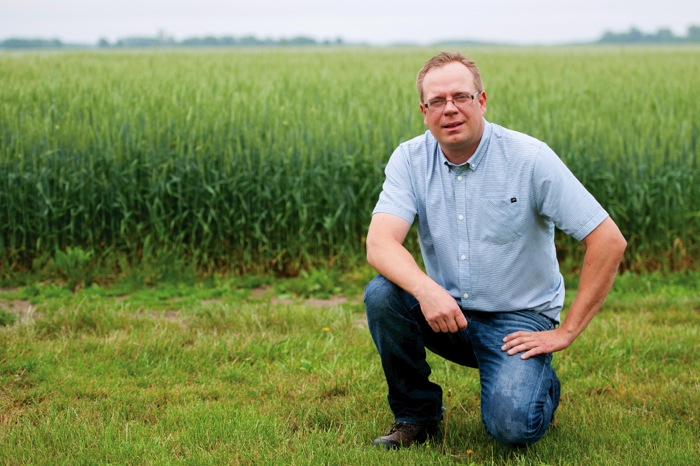Too often, talk about wheat yields in Eastern Canada turns to what’s happening in places like Kansas, the United Kingdom or northern Europe, as if our best hope to increase our productivity here is to use the ideas they’re developing there.
Increasingly, however, the smart money is on taking a harder look at our own fields for the answers to our yield limitations.
There’s no doubt, after all, that wheat seems stuck in third place among our major crops. In corn, many growers in Canada have eclipsed 200 bu./ac. and are now aiming at 300. Soybean yields have been climbing well into the upper 40s, and into the 50s in some fields. During the 2012 drought year, parts of fields ran into the 70s, with one grower in Chatham-Kent touching the century mark, even though it was only for about 100 feet.
Read Also

Could crop sharing be a viable option for your farm?
Crop sharing could be a good option for young and beginning farmers.
But wheat? With yields averaging 85 to 90 bushels per acre (although a few growers consider anything less than 100 to be a poor crop), wheat just hasn’t been a crop to get excited about.
Some of the explanation for that is steeped in history, and some of it is related to genetics. But much of it is based on agronomics and management.
From a historical perspective, Peter Johnson believes it goes back to the days of single-desk marketing. From roughly 1980 to 2000, wheat acres in the province were in the 500,000- to 600,000-acre range. By 2000, the Ontario Wheat Producers’ Marketing Board had begun its march to off-board marketing. That did a lot to change the default mindset that the board’s marketing process created.
“The challenge was, I plant my wheat in September-October, apply my fertilizer in April, harvest it in July and I get my initial payment in August or September,” says Johnson, cereal specialist with Ontario’s Ministry of Agriculture and Food (OMAF). “Then the final payment some years didn’t show up for 18 months.”
But that changed dramatically with the switch from single-desk marketing. Since then wheat acres have jumped to the 800,000-acre mark, with intentions every fall to go to a million acres, weather permitting, mostly because there’s more control over marketing and cash flow for the grower.
Genetics and management
Genetics is another issue that has held the crop back, especially in Eastern Canada. Corn and soybeans have benefited from considerable investment in plant breeding and transgenic trait development, but wheat has been sidetracked by federal and provincial funding cuts, not to mention the use of bin-run seed. That latter issue has played an unfortunate role in slowing research into improved varieties.
Fall weed management is another issue. According to Johnson, only five per cent of acres in Ontario have a fall weed management program, with “timing” the main factor (with soybean harvest, planting winter wheat, corn harvest plus fall tillage and any fertilizer applications — who has time for fall weed management?).
Then in spring, there’s the rush to get the first nitrogen application on wheat, plus any early herbicides, all without complicating corn planting.
Still, Johnson is optimistic about progress in seed genetics in wheat. There’s still some wheat breeding being done at the federal level, and there are signs that private-sector investment is ramping up. Hyland Seeds has declared it will focus on wheat (unlike oats or barley), Syngenta has been investing more, and so have Pioneer and Monsanto.
“At the end of the day, we need more genetic progress, and we need more agronomic progress,” says Johnson. “I’ve learned that the two have to go hand in hand. If you don’t have the genetic yield potential, you can manage it to the nth degree, but you just don’t go anywhere. If you have the genetic yield potential and you do the right agronomic things to protect and achieve the yield potential, then you can make real headway.”
Most scientific studies have found that yield gain in most crops is 50 per cent genetic and 50 per cent agronomic. There’s a synergy — you must have the genetics or the agronomics don’t work, yet without the agronomics, the genetics won’t respond. It’s similar to testing higher nitrogen rates with fungicide applications, which have also boosted yield.
Also worth remembering is that fungicides can provide an extra eight to 10 per cent yield, but not because of disease protection from something such as fusarium head blight.
“In fact, it’s very rare to see significant yield gains to fusarium,” says Johnson. “We did last year (2013) because we had a fusarium outbreak, but 19 years out of 20, I get that yield gain because I’ve kept the leaf tissue and the stem greener, longer, and I combined that crop three days later because it was too tough when the unsprayed crop was ready. All I did was lengthen grain-fill by keeping the crop greener so it matured, rather than die due to the disease.”

Managing the zones
Determining the “what” and “why” is also important to Phil Needham, who has devoted much of the past 25 years to helping growers in North America grow better wheat using what can be considered European methods.
Needham operates Needham Ag Technologies from his base in Calhoun, Kentucky, and is a native of Lincolnshire, England. He focuses on a common-sense approach built around strong agronomics.
Among the parameters that Needham relies on are better seed, proper seeding depth, phosphorus in the row at planting, soil testing, even emergence and uniform stands, uniform and timely nitrogen applications and weed, disease and insect monitoring.
There may be little that’s revolutionary here, yet Needham suggests that too many growers treat their wheat as though all of these things occur evenly across an entire field, which is not the case.
“If you have a farmer who’s making 90-bushel wheat or 100-bushel wheat, just as an example, if he has a calibrated yield monitor, I’m going to guess that his yields probably go from 50 as the low to 150 as a high,” says Needham. “Using that starting point, I don’t think there are many growers out there managing things as well as they could.”
In the field of wheat genetics, Needham’s perspective mirrors Johnson’s.
“Corn and soybean genetics have run forward at a pretty rapid pace compared to wheat genetics, which barely advanced in the past 10 to 15 years,” says Needham. “A big part is that a lot of producers have been saving their wheat seed, and therefore a lot of the royalties haven’t been high enough to get a lot of interest from plant breeders on spending a lot of time on wheat genetics.”
In spite of that shortfall, Needham sticks to an approach that values how you use what you have instead of lamenting over what you don’t. Technology is important but having an unmanned aerial vehicle or a precision planter doesn’t automatically make you a better farmer. Needham believes in sticking to the fundamentals. He cites one farmer using a GreenSeeker sensor and applying liquid nitrogen on his wheat at rates of seven to 24 gallons per acre across the field.
“You need to figure out which zones are high yielding, which zones are low yielding,” says Needham. “Concentrate on where those zones are and try to figure out what you need to do to improve the performance of the lower-yielding zones or improve yields from the high-yielding zones.”
Timing is another important commodity in boosting wheat yields, whether it’s timing on planting, weed control or the use of a fungicide. Needham’s grandfather often told him that the difference between a good farmer and a bad farmer is a week. Still, without adhering to the fundamentals, timing can be almost irrelevant.
Says Needham: “Starting with good seed, good genetics for your region, a good fertility plan, good seeding depth, good residue distribution, all of the fertility practices — half of the yield potential is gathered or lost by emergence.”
Making it work
Ken Hoeper is a follower of many of Needham’s management practices. In 1985, Hoeper and his family came to Ontario’s Huron County from northern Germany, and for the most part, he’s been growing wheat the same way since he arrived.
Farming at Amberley, south of Kincardine, Hoeper has 1,200 acres, which he splits into two rotations: winter wheat-winter barley-white (navy) beans on half, and winter wheat-corn-soybeans on the other half.
Hoeper also agrees with Needham’s assessment that wheat doesn’t have the same level of importance as corn and soybeans, but he maintains growers need to shift their practices in order to boost yield.
One thing Hoeper does differently is to scout his wheat early, as in the first week of April — once a week.
“Then we begin to increase that frequency as the crop begins to head out,” says Hoeper, always on the lookout for fusarium head blight.
Hoeper has also used growth regulators — he used Cycocel when it was the only one on the market — and he splits his N applications using two per year, although sometimes he’ll apply about 20 lbs. of 28 per cent roughly two weeks after the first application of N, but again that depends on the growing season.
“The main reason for that is to not apply too much all at once,” says Hoeper, adding that coming out of dormancy, wheat can’t take a sudden shot with amounts like 100 lbs. of N. “The last application is done with urea or ammonium nitrate, with a three-point hitch spreader at Zadoks 37, and usually we apply 40 to 60 lbs.”
Hoeper also agrees with Needham and Johnson that conditions in Europe are considerably different from those here in North America. The biggest factor he sees is the day length, which is longer in northern Germany and the U.K., and that, says Hoeper, is likely not appreciated as much as it should be.
“They have more daylight hours, especially at grain-fill,” Hoeper says. “And they don’t have much of a winter. They would start putting on their nitrogen at the end of January or the beginning of February.”
That spread in nitrogen applications compared to harvesting in Europe — usually at the end of August — is uncommonly long, and creates a distinct advantage for yield. Growers in the U.K. and northern Europe have a grain-fill period of roughly 60 days, longer than anywhere in North America.
Temperatures are also cooler in northern Europe and day length is yet another factor: farther north, a crop may lose some of the grain-fill period, but it gains substantially in day length. Even a 45-day grain-fill period benefits from more hours of sunlight, which mean more photosynthate to boost yield.
















